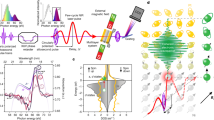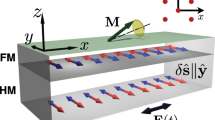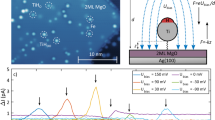Abstract
Electrical control of spins at the nanoscale offers significant architectural advantages in spintronics, because electric fields can be confined over shorter length scales than magnetic fields1,2,3,4,5. Thus, recent demonstrations of electric-field sensitivities in molecular spin materials6,7,8 are tantalizing, raising the viability of the quantum analogues of macroscopic magneto-electric devices9,10,11,12,13,14,15. However, the electric-field sensitivities reported so far are rather weak, prompting the question of how to design molecules with stronger spin–electric couplings. Here we show that one path is to identify an energy scale in the spin spectrum that is associated with a structural degree of freedom with a substantial electrical polarizability. We study an example of a molecular nanomagnet in which a small structural distortion establishes clock transitions (that is, transitions whose energy is to first order independent of the magnetic field) in the spin spectrum; the fact that this distortion is associated with an electric dipole allows us to control the clock-transition energy to an unprecedented degree. We demonstrate coherent electrical control of the quantum spin state and exploit it to independently manipulate the two magnetically identical but inversion-related molecules in the unit cell of the crystal. Our findings pave the way for the use of molecular spins in quantum technologies and spintronics.
This is a preview of subscription content, access via your institution
Access options
Access Nature and 54 other Nature Portfolio journals
Get Nature+, our best-value online-access subscription
$29.99 / 30 days
cancel any time
Subscribe to this journal
Receive 12 print issues and online access
$209.00 per year
only $17.42 per issue
Buy this article
- Purchase on Springer Link
- Instant access to full article PDF
Prices may be subject to local taxes which are calculated during checkout



Similar content being viewed by others
Data availability
Experimental data supporting the conclusions are available at https://doi.org/10.5281/zenodo.5167019.
References
Kane, B. E. A silicon-based nuclear spin quantum computer. Nature 393, 133–137 (1998).
Trif, M., Troiani, F., Stepanenko, D. & Loss, D. Spin-electric coupling in molecular magnets. Phys. Rev. Lett. 101, 217201 (2008).
Laucht, A. et al. Electrically controlling single-spin qubits in a continuous microwave field. Sci. Adv. 1, e1500022 (2015).
Tosi, G. et al. Silicon quantum processor with robust long-distance qubit couplings. Nat. Commun. 8, 450 (2017).
Asaad, S. et al. Coherent electrical control of a single high-spin nucleus in silicon. Nature 579, 205–209 (2020).
Liu, J. et al. Electric field control of spins in molecular magnets. Phys. Rev. Lett. 122, 037202 (2019).
Fittipaldi, M. et al. Electric field modulation of magnetic exchange in molecular helices. Nat. Mater. 18, 329–334 (2019).
Robert, J., Parizel, N., Turek, P. & Boudalis, A. K. Polyanisotropic magnetoelectric coupling in an electrically controlled molecular spin qubit. J. Am. Chem. Soc. 141, 19765–19775 (2019).
Palii, A., Clemente-Juan, J. M., Tsukerblat, B. & Coronado, E. Electric field control of the optical properties in magnetic mixed-valence molecules. Chem. Sci. 5, 3598–3602 (2014).
Cardona-Serra, S. et al. Electrically switchable magnetic molecules: inducing a magnetic coupling by means of an external electric field in a mixed-valence polyoxovanadate cluster. Chem. Eur. J. 21, 763–769 (2015).
Gaita-Ariño, A., Luis, F., Hill, S. & Coronado, E. Molecular spins for quantum computation. Nat. Chem. 11, 301–309 (2019).
Atzori, M. & Sessoli, R. The second quantum revolution: role and challenges of molecular chemistry. J. Am. Chem. Soc. 141, 11339–11352 (2019).
Godfrin, C. et al. Operating quantum states in single magnetic molecules: implementation of Grover’s quantum algorithm. Phys. Rev. Lett. 119, 187702 (2017).
Eerenstein, W., Mathur, N. D. & Scott, J. F. Multiferroic and magnetoelectric materials. Nature 442, 759–765 (2006).
Matsukura, F., Tokura, Y. & Ohno, H. Control of magnetism by electric fields. Nat. Nanotechnol. 10, 209–220 (2015).
AlDamen, M. A. et al. Mononuclear lanthanide single molecule magnets based on the polyoxometalates [Ln(W5O18)2]9− and [Ln(β2-SiW11O39)2]13− (LnIII = Tb, Dy, Ho, Er, Tm, and Yb). Inorg. Chem. 48, 3467–3479 (2009).
Shiddiq, M. et al. Enhancing coherence in molecular spin qubits via atomic clock transitions. Nature 531, 348–351 (2016).
Ghosh, S. et al. Multi-frequency EPR studies of a mononuclear holmium single-molecule magnet based on the polyoxometalate [HoIII(W5O18)2]9−. Dalton Trans. 41, 13697–13704 (2012).
Alvarez, S., Alemany, P., Casanova, D., Cirera, J. & Llunell, M. Shape maps and polyhedral interconversion paths in transition metal chemistry. Coord. Chem. Rev. 249, 1693–1708 (2005).
Frisch, M. J. et al. Gaussian 16 Revision A.03 (Gaussian, 2016).
Sarkar, A. & Rajaraman, G. Modulating magnetic anisotropy in Ln(iii) single-ion magnets using an external electric field. Chem. Sci. 11, 10324–10330 (2020).
Wedge, C. J. et al. Chemical engineering of molecular qubits. Phys. Rev. Lett. 108, 107204 (2012).
Kintzel, B. et al. Spin-electric coupling in a cobalt(II)-based spin triangle revealed by electric-field-modulated electron spin resonance spectroscopy. Angew. Chem. Int. Ed. 60, 8832–8838 (2021).
Liu, Z. et al. Electric field manipulation enhanced by strong spin-orbit coupling: promoting rare-earth ions as qubits. Natl Sci. Rev. 7, 1557–1563 (2020).
George, R. E., Edwards, J. P. & Ardavan, A. Coherent spin control by electrical manipulation of the magnetic anisotropy. Phys. Rev. Lett. 110, 027601 (2013).
Mi, X. et al. A coherent spin–photon interface in silicon. Nature 555, 599–603 (2018).
Fdez. Galvan, I. et al. Openmolcas: from source code to insight. J. Chem. Theory Comput. 15, 5925–5964 (2019).
Ungur, L. & Chibotaru, L. F. Ab initio crystal field for lanthanides. Chem. Eur. J. 23, 3708–3718 (2017).
Acknowledgements
This work is supported by the EU (ERC-2014-CoG-647301 DECRESIM, ERC-2018-AdG-788222 MOL-2D, COST Action CA15128 MOLSPIN, the QuantERA project SUMO, and the H2020 research and innovation programme projects SPRING (no. 863098) and FATMOLS (no. 862893)); the Spanish MINECO (grant CTQ2017-89993 co-financed by FEDER and grant MAT2017-89528; the Unit of Excellence ‘María de Maeztu’ CEX2019-000919-M); the Generalitat Valenciana (Prometeo Program of Excellence); and the UK EPSRC (EP/P000479/1). J.J.B. acknowledges support by the Generalitat Valenciana (CDEIGENT/2019/022). J.M. is supported by Magdalen College, Oxford. J.L. is supported by the Royal Society through a University Research Fellowship.
Author information
Authors and Affiliations
Contributions
J.L., E.C., A.G.-A. and A.A. conceived the study. Materials were synthesized by Y.D. under the supervision of E.C. ESR experiments were conducted by J.L. and J.M. Data analysis was performed by J.L. with input from A.A. Theoretical modelling was done by A.U.; assisted by J.J.B.; guided by A.G.-A.; and in discussion with J.L., E.C. and A.A. All the authors contributed to the manuscript.
Corresponding authors
Ethics declarations
Competing interests
The authors declare no competing interests.
Additional information
Peer review information Nature Physics thanks Nicholas Chilton, Stergios Piligkos and the other, anonymous, reviewer(s) for their contribution to the peer review of this work.
Publisher’s note Springer Nature remains neutral with regard to jurisdictional claims in published maps and institutional affiliations.
Supplementary information
Supplementary Information
Supplementary Figs. 1–20, Discussion and Tables 1–6.
Supplementary Video 1
Electric-field-induced distortion of the crystal structure.
Supplementary Video 2
Electric-field-induced distortion of the optimized structure.
Rights and permissions
About this article
Cite this article
Liu, J., Mrozek, J., Ullah, A. et al. Quantum coherent spin–electric control in a molecular nanomagnet at clock transitions. Nat. Phys. 17, 1205–1209 (2021). https://doi.org/10.1038/s41567-021-01355-4
Received:
Accepted:
Published:
Issue Date:
DOI: https://doi.org/10.1038/s41567-021-01355-4
This article is cited by
-
Electrically controlled nonvolatile switching of single-atom magnetism in a Dy@C84 single-molecule transistor
Nature Communications (2024)
-
Electric control of spin transitions at the atomic scale
Nature Communications (2023)
-
Electron-nuclear decoupling at a spin clock transition
Communications Physics (2023)
-
Electrical two-qubit gates within a pair of clock-qubit magnetic molecules
npj Quantum Information (2022)
-
Quantum-coherent nanoscience
Nature Nanotechnology (2021)



